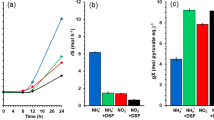Abstract
The assimilation of nitrate, a nitrogenous compound, was previously described as an important factor favoring Dekkera bruxellensis in the competition with Saccharomyces cerevisiae for the industrial sugarcane substrate. In this substrate, nitrogen sources are limited and diverse, and a recent report showed that amino acids enable D. bruxellensis to grow anaerobically. Thus, understanding the regulation of nitrogen metabolism is one fundamental aspect to comprehend the competiveness of D. bruxellensis in the fermentation environment. In the present study, we evaluated the physiological and transcriptional profiles of D. bruxellensis in response to different carbon and nitrogen supplies to determine their influence on growth, sugar consumption, and ethanol production. Besides, the expression of genes coding for nitrogen permeases and enzymes involved in the biosynthesis of glutamate and energetic metabolism were investigated under these conditions. Our data revealed that genes related to nitrogen uptake in D. bruxellensis are under the control of nitrogen catabolite repression. Moreover, we provide indications that glutamate dehydrogenase and glutamate synthase may switch roles as the major pathway for glutamate biosynthesis in D. bruxellensis. Finally, our data showed that in nonoptimal growth conditions, D. bruxellensis leans toward the respiratory metabolism. The results presented herein show that D. bruxellensis and S. cerevisiae share similar regulation of GDH–GOGAT pathway, while D. bruxellensis converts less glucose to ethanol than S. cerevisiae do when nitrogen is limited. The consequence of this particularity to the industrial process is discussed.

Similar content being viewed by others
References
Barel I, MacDonald DW (1993) Enzyme defects in glutamate requiring strains of Schizosaccharomyces pombe. FEMS Microbiol Lett 113:267–272
Basílio ACM, de Araújo PRL, de Morais JOF, da Silva Filho EA, de Morais MA, Simões DA (2008) Detection and identification of wild yeast contaminants of the industrial fuel ethanol fermentation process. Curr Microbiol 56:322–326
Blomqvist J, Eberhard T, Schnürer J, Passoth V (2010) Fermentation characteristics of Dekkera bruxellensis strains. Appl Microbiol Biotechnol 87:1487–1497
Blomqvist J, Nogué VS, Gorwa-Grauslund M, Passoth V (2012) Physiological requirements for growth and competitiveness of Dekkera bruxellensis under oxygen-limited or anaerobic conditions. Yeast 29:265–274
Boer VM, Tai SL, Vuralhan Z, Arifin Y, Walsh MC, Piper MDW, de Winde JH, Pronk JT, Daran JM (2007) Transcriptional responses of Saccharomyces cerevisiae to preferred and nonpreferred nitrogen sources in glucose-limited chemostat cultures. FEMS Yeast Res 7:604–620
Bustin SA, Benes V, Garson JA, Hellemans J, Huggett J, Kubista M, Mueller R, Nolan T, Pfaffl MW et al (2009) The MIQE guidelines: minimum information for publication of quantitative real-time PCR experiments. Clin Chem 55:611–622
Cain NE, Kaiser CA (2011) Transport activity-dependent intracellular sorting of the yeast general amino acid permease. Mol Biol Cell 22:1919–1929
Carlson M (1999) Glucose repression in yeast. Curr Opin Microbiol 2:202–207
Chatonnet P, Dubourdieu D, Boidron JN (1995) The influence of Brettanomyces/Dekkera sp. yeast and lactic acid bacteria on the ethyl phenol content of red wines. Am J Enol Vitic 46:463–468
Chatonnet P, Viala C, Dubourdieu D (1997) Influence of polyphenolic components of red wines on the microbial synthesis of volatile phenols. Am J Enol Vitic 48:443–448
Coffman JA, Rai R, Cunningham T, Svetlov V, Cooper TG (1996) Gat1p, a GATA family protein whose production is sensitive to nitrogen catabolite repression, participates in transcriptional activation of nitrogen-catabolic genes in Saccharomyces cerevisiae. Mol Cell Biol 16:847–858
Conterno L, Joseph CML, Arvik TJ, Henick-kling T, Bisson LF (2006) Genetic and physiological characterization of Brettanomyces bruxellensis strains isolated from wines. Am J Enol Vitic 57:139–147
Cooper TG (2002) Transmitting the signal of excess nitrogen in Saccharomyces cerevisiae from the Tor proteins to the GATA factors: connecting the dots. FEMS Microbiol Rev 26:223–238
de Barros Pita W, Leite FCB, de Souza Liberal AT, Simões DA, de Morais MA Jr (2011) The ability to use nitrate confers advantage to Dekkera bruxellensis over S. cerevisiae and can explain its adaptation to industrial fermentation processes. Antonie Van Leeuwenhoek 100:99–107
de Barros Pita W, Leite FCB, de Souza Liberal AT, Pereira LF, Carazzolle MF, Pereira GA, De Morais MA Jr (2012) A new set of reference genes for RT-qPCR assays in the yeast Dekkera bruxellensis. Can J Microbiol 58:1362–1367
de Barros Pita W, Tiukova I, Leite FCB, Passoth V, Simões DA, de Morais MA Jr (2013) The influence of nitrate on the physiology of the yeast Dekkera bruxellensis grown under oxygen limitation. Yeast 30:111–117
de Morais MA Jr (2003) The NADP+-dependent glutamate dehydrogenase of the yeast Kluyveromuces marxianus responds to nitrogen repression similarly to Saccharomyces cerevisaie. Braz J Microbiol 34:334–338
de Souza Liberal AT, Basílio ACM, do Monte Resende A, Brasileiro BTV, da Silva-Filho EA, de Morais JOF, Simões DA, de Morais MA Jr (2007) Identification of Dekkera bruxellensis as a major contaminant yeast in continuous fuel ethanol fermentation. J Appl Microbiol 102:538–547
DeLuna A, Avendaño A, Riego L, Gonzalez A (2001) NADP-glutamate dehydrogenase isoenzymes of Saccharomyces cerevisiae. Purification, kinetic properties, and physiological roles. J Biol Chem 276:43775–43783
Freese S, Vogts T, Speer F, Schäfer B, Passoth V, Klinner U (2011) C- and N-catabolic utilization of tricarboxylic acid cycle-related amino acids by Scheffersomyces stipitis. Yeast 28:375–390
Galafassi S, Capusoni C, Moktaduzzaman M, Compagno C (2013) Utilization of nitrate abolishes the “Custers effect” in Dekkera bruxellensis and determines a different pattern of fermentation products. J Ind Microbiol Biotechnol 40:297–303
Gancedo JM (1998) Yeast carbon catabolite repression. Microbiol Mol Biol Rev 62:334–361
Godard P, Urrestarazu A, Vissers S, Kontos K, Bontempi G, van Helden J, Andre B (2007) Effect of 21 different nitrogen sources on global gene expression in the yeast Saccharomyces cerevisiae. Mol Cell Biol 27:3065–3086
Holmes AR, Collings A, Farnden KJF, Sheperd MG (1989) Ammonium assimilation by Candida albicans and other yeasts: evidence for activity of glutamate synthase. J Gen Microbiol 135:1423–1430
Jauniaux JC, Grenson M (1990) GAP1, the general amino acid permease gene of Saccharomyces cerevisiae. Nucleotide sequence, protein similarity with the other bakers yeast amino acid permeases, and nitrogen catabolite repression. Eur J Biochem 190:39–44
Leite FCB, Basso TO, de Barros Pita W, Gombert AK, Simões DA, de Morais MA (2013) Quantitative aerobic physiology of the yeast Dekkera bruxellensis, a major contaminant in bioethanol production plants. FEMS Yeast Res 13:34–43
Loureiro V, Malfeito-Ferreira M (2003) Spoilage yeasts in the wine industry. Int J Food Microbiol 86:23–50
Magasanik B (2003) Ammonia assimilation by Saccharomyces cerevisiae. Eukaryot Cell 2:827–829
Magasanik B, Kaiser CA (2002) Nitrogen regulation in Saccharomyces cerevisiae. Gene 290:1–18
Marini AM, Vissers S, Urrestarazu A, Andre B (1994) Cloning and expression of the MEP1 gene encoding an ammonium transporter in Saccharomyces cerevisiae. EMBO J 13:3456–3463
Marini AM, Soussi-Boudekou S, Vissers S, Andre B (1997) A family of ammonium transporters in Saccharomyces cerevisiae. Mol Cell Biol 17:4282–4293
Marini AM, Springael JY, Frommer WB, Andre B (2000) Cross-talk between ammonium transporters in yeast and interference by the soybean SAT1 protein. Mol Microbiol 35:378–385
Mendes-Ferreira A, del Olmo M, García-Martínez J, Jiménez-Martí E, Mendes-Faia A, Pérez-Ortín JE, Leão C (2007) Transcriptional response of Saccharomyces cerevisiae to different nitrogen concentrations during alcoholic fermentation. Appl Environ Microbiol 73:3049–3060
Miller SM, Magasanik B (1990) Role of NAD-linked glutamate dehydrogenase in nitrogen metabolism in Saccharomyces cerevisiae. J Bacteriol 172:4927–4935
Passoth V, Blomqvist J, Schnürer J (2007) Dekkera bruxellensis and Lactobacillus vini form a stable ethanol-producing consortium in a commercial alcohol production process. Appl Environ Microbiol 73:4354–4356
Pereira EVS, Dos Anjos RSG, Basílio ACM, Leite FCB, de Morais MA Jr, Simões DA (2010) Challenging metabolic engineering concepts to industrial conditions: the modifications in redox metabolism of S. cerevisiae for bioethanol. J Biotechnol 150:165
Regenberg B, During-Olsen L, Kielland-Brandt MC, Holmberg S (1999) Substrate specificity and gene expression of the amino-acid permeases in Saccharomyces cerevisiae. Curr Genet 36:317–328
Riego L, Avendaño A, DeLuna A, Rodríguez E, González A (2002) GDH1 expression is regulated by GLN3, GCN4, and HAP4 under respiratory growth. Biochem Biophys Res Commun 293:79–85
Romero M, Guzmán-León S, Aranda C, González-Halphen D, Valenzuela L, González A (2000) Pathways for glutamate biosynthesis in the yeast Kluyveromyces lactis. Microbiology 146:239–245
Stanbrough M, Magasanik B (1995) Transcriptional and posttranslational regulation of the general amino acid permease of Saccharomyces cerevisiae. J Bacteriol 177:94–102
ter Schure EG, Silljé HH, Vermeulen EE, Kalhorn JW, Verkleij AJ, Boonstra J, Verrips CT (1998) Repression of nitrogen catabolic genes by ammonia and glutamine in nitrogen-limited continuous cultures of Saccharomyces cerevisiae. Microbiology 144:1451–1462
Usaite R, Patil KR, Grotkjaer T, Nielsen J, Regenberg B (2006) Global transcriptional and physiological responses of Saccharomyces cerevisiae to ammonium, l-alanine, or l-glutamine limitation. Appl Environ Microbiol 72:6194–6203
Valenzuela L, Ballario P, Aranda C, Filetici P, González A (1998) Regulation of expression of GLT1, the gene encoding glutamate synthase in Saccharomyces cerevisiae. J Bacteriol 180:3533–3540
Vandesompele J, De Preter K, Pattyn F, Poppe B, Van Roy N, De Paepe A, Speleman F (2002) Accurate normalization of real-time quantitative RT-PCR data by geometric averaging of multiple internal control genes. 3. Genome Biol 3:0034.1–0034.11
Acknowledgments
This study was sponsored by the Bioethanol Research Network of the State of Pernambuco (CNPq-FACEPE/PRONEM program) and the Brazilian funding agencies Conselho Nacional de Desenvolvimento Científico e Tecnológico (CNPq), Coordenação de Aperfeiçoamento de Pessoal de Nível Superior (CAPES), and Fundação de Amparo a Ciência e Tecnologia do Estado de Pernambuco (FACEPE). VP was supported by the MicroDrive-programme at the NL-faculty of SLU.
Author information
Authors and Affiliations
Corresponding author
Electronic supplementary material
Below is the link to the electronic supplementary material.
Rights and permissions
About this article
Cite this article
de Barros Pita, W., Silva, D.C., Simões, D.A. et al. Physiology and gene expression profiles of Dekkera bruxellensis in response to carbon and nitrogen availability. Antonie van Leeuwenhoek 104, 855–868 (2013). https://doi.org/10.1007/s10482-013-9998-x
Received:
Accepted:
Published:
Issue Date:
DOI: https://doi.org/10.1007/s10482-013-9998-x




